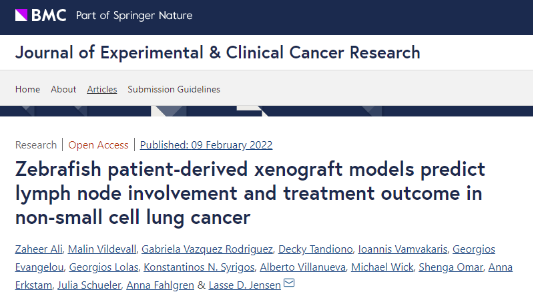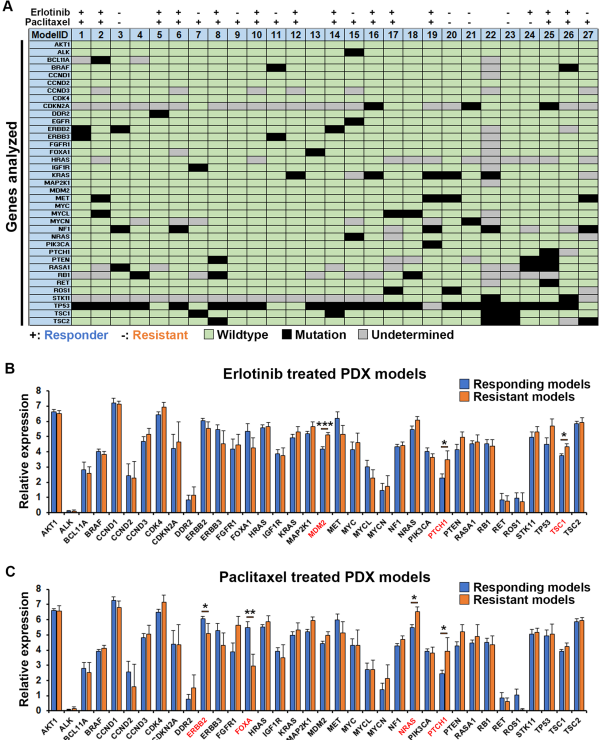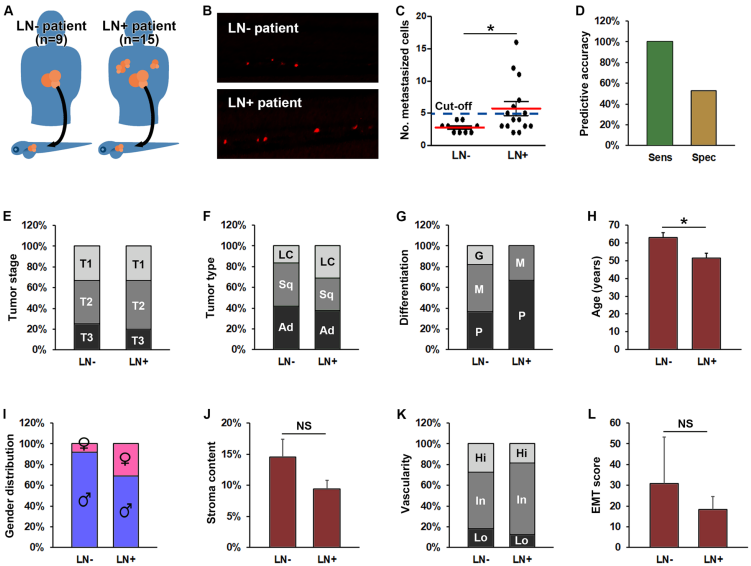
原文獻:Ali, Z., Vildevall, M., Rodriguez, G.V. et al. Zebrafish patient-derived xenograft models predict lymph node involvement and treatment outcome in non-small cell lung cancer. J Exp Clin Cancer Res 41, 58 (2022).
原文鏈接:https://doi.org/10.1186/s13046-022-02280-x
癌癥患者在治療效果和腫瘤侵襲性方面表現出高度的個體差異,而這兩方面恰恰是影響腫瘤患者生存的關鍵所在,因此,準確預測腫瘤轉移風險和治療結果對個體化治療至關重要[1]。小鼠患者源性異種移植(PDX)模型在預測治療結果方面表現出很高的準確性,但預測腫瘤侵襲性的方法仍然缺乏。另外,小鼠PDX實驗周期較長,難以滿足臨床個體化治療的需求[2-4]。
近年來,斑馬魚腫瘤異種移植(zPDX)系統已成為腫瘤學和腫瘤生物學研究中一種強有力的體內補充系統[5,6]。通過移植腫瘤細胞系來生成zCDX模型,已經使我們對驅動早期腫瘤擴散的分子和病理生理事件[7,8]、腫瘤微環境內的相互作用[9,10]以及對藥物或治療的反應[11-13]有了更深入的理解。由于已建立的細胞系可能隨著時間的推移而發生表型變化,這些模型主要用于基礎研究或早期臨床前藥物開發。為了更好地保持患者腫瘤的特征,研究者成功構建了直接移植患者來源的腫瘤樣本的zPDX模型,并證明該模型能夠準確地反應相應患者的腫瘤特性[14-19]。
本研究開發了一種新的、可靠的方法,成功將非小細胞肺癌(NSCLC)組織植入到斑馬魚幼魚中建立zPDX模型。該zPDX模型準確地再現了相應小鼠PDX模型和患者自身對紫杉醇和厄洛替尼的反應。重要的是,該zPDX平臺預測腫瘤向患者淋巴結擴散的敏感性為91%,而預測淋巴結無侵犯的特異性為62%。
● 主要研究結果
1. 對比凍存的組織與單細胞懸液,研究結果顯示凍存的患者組織移植成功率優于凍存的患者單細胞懸液,組織移植成功率高于80%(圖1)。

圖1
2、用25例zPDX模型評價厄洛替尼和紫杉醇的腫瘤治療效果,結果顯示厄洛替尼和紫杉醇在zPDX上對NSCLC腫瘤的治療有效率與真實世界中患者的治療有效率相似(圖2D、E)。與藥物評價的金標準小鼠PDX模型對比,zPDX對厄洛替尼和紫杉醇的應答與小鼠PDX高度一致(圖2F、G)。

圖2
3. 將腫瘤組織進行測序分析,對比與藥物治療相關的靶點后發現,厄洛替尼和紫杉醇在zPDX上的治療效果與基因檢測結果相似(圖3)。

圖3
4、將發生轉移和未發生轉移患者的腫瘤組織移植至斑馬魚,實驗結果顯示zPDX模型預測腫瘤向患者淋巴結擴散的敏感性為91%,而預測淋巴結無侵犯的特異性為62%(圖4),提示zPDX模型可準確預測患者體內腫瘤轉移的發生。

圖4
環特生物作為斑馬魚技術應用領導者,深度挖掘、創新斑馬魚技術的應用場景,在原有斑馬魚CDX模型用于抗腫瘤藥物藥效評價的基礎上,成功建立多種實體瘤斑馬魚PDX藥敏評價體系,實現臨床應用,為患者提供精準的用藥指導。同時,我們積極進行基于真實世界腫瘤患者的臨床研究,聯合浙江大學附屬第二醫院開展全世界首個胃癌斑馬魚PDX與患者治療效果的一致性評價項目(Clinical Trials注冊號:NCT05616533,為斑馬魚PDX的臨床應用提供更加充分的科學依據。
參考資料:
1. Eberhardt WE, et al. 2nd ESMO Consensus Conference in Lung Cancer: locally advanced stage III non-small-cell lung cancer. Ann Oncol. 2015;26:1573–88.
2. Hidalgo M, et al. Patient-derived xenograft models: an emerging platform for translational cancer research. Cancer Discov. 2014;4:998–1013.
3. Schueler J, et al. Patient derived renal cell carcinoma xenografts exhibit distinct sensitivity patterns in response to antiangiogenic therapy and constitute a suitable tool for biomarker development. Oncotarget. 2018;9:30946–61.
4. Schueler J, et al. Induction of Acquired Resistance towards EGFR Inhibitor Gefitinib in a Patient-Derived Xenograft Model of Non-Small Cell Lung Cancer and Subsequent Molecular Characterization. Cells. 2019;8(7):740.
5. Rouhi P, et al. Hypoxia-induced metastasis model in embryonic zebrafish. Nat Protoc. 2010;5:1911–8.
6. Xiao J, Glasgow E, Agarwal S. Zebrafish Xenografts for Drug Discovery and Personalized Medicine. Trends Cancer. 2020;6:569–79.
7. Liu C, et al. A Zebrafish Model Discovers a Novel Mechanism of Stromal Fibroblast-Mediated Cancer Metastasis. Clin Cancer Res. 2017;23:4769–79.
8. Svensson S, et al. CCL2 and CCL5 Are Novel Therapeutic Targets for Estrogen-Dependent Breast Cancer. Clin Cancer Res. 2015;21:3794–805.
9. Vazquez Rodriguez G, Abrahamsson A, Jensen LD, Dabrosin C. Estradiol Promotes Breast Cancer Cell Migration via Recruitment and Activation of Neutrophils. Cancer Immunol Res. 2017;5:234–47.
10. Vazquez Rodriguez G, Abrahamsson A, Jensen LDE, Dabrosin C. Adipocytes Promote Early Steps of Breast Cancer Cell Dissemination via Interleukin-8. Front Immunol. 2018;9:1767.
11. He X, et al. Visualization of human T lymphocyte-mediated eradication of cancer cells in vivo. Proc Natl Acad Sci U S A. 2020;117:22910–9.
12. Kabakci Z, et al. Pharmacophore-guided discovery of CDC25 inhibitors causing cell cycle arrest and tumor regression. Sci Rep. 2019;9:1335.
13. Selvaraju K, et al. Cytotoxic unsaturated electrophilic compounds commonly target the ubiquitin proteasome system. Sci Rep. 2019;9:9841.
14. Fior R, et al. Single-cell functional and chemosensitive profiling of combinatorial colorectal therapy in zebrafish xenografts. Proc Natl Acad Sci U S A. 2017;114:E8234–43.
15. Gaudenzi G, et al. Patient-derived xenograft in zebrafish embryos: a new platform for translational research in neuroendocrine tumors. Endocrine. 2017;57:214–9.
16. Gaudenzi G, et al. Patient-derived xenograft in zebrafish embryos: a new platform for translational research in neuroendocrine tumors. Endocrine. 2017;57:214–9.
17. Wu JQ, et al. Patient-derived xenograft in zebrafish embryos: a new platform for translational research in gastric cancer. J Exp Clin Cancer Res. 2017;36:160.
18. Lin J, et al. A clinically relevant in vivo zebrafish model of human multiple myeloma to study preclinical therapeutic efficacy. Blood. 2016;128:249–52.
19. Costa B, et al. Developments in zebrafish avatars as radiotherapy sensitivity reporters - towards personalized medicine. EBioMedicine. 2020;51:102578.





 17312606166
17312606166